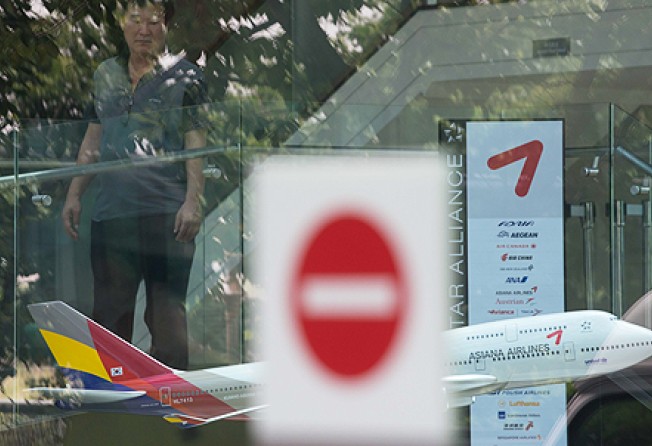Asiana crash in San Francisco mars record of Boeing 777

The crash of a South Korean airliner in San Francisco that killed two people dampens the safety record of one of the world's safest aircraft.
Saturday's crash was the first fatal accident involving a Boeing 777, a family of twin-engined long-haul aircraft that has been in service for the past 18 years. With more than five million flights, according to Boeing, it remains one of the industry's solid workhorses.
It would also be the third fatal accident involving one of Asia's fastest growing full-service airlines, which first began operations in 1988 as a rival to South Korea's flag carrier, Korean Air Lines.
There was no immediate clue on the possible cause of the crash. The US National Transportation Safety Board said it was sending a team to start examining the wreckage.
The aircraft that crashed on Saturday was seven years old, having left the Boeing factory in 2006. It is a 777-200ER, a version of Boeing's "mini-jumbo" 777 family capable of transporting 301 passengers in standard cabin layouts up to 14,300 kilometres.
In January 2008, all passengers and crew survived when a similar British Airways 777-200ER crash-landed metres short of the runway at London's Heathrow Airport.
A two-year investigation blamed the crash on a fuel blockage caused by the release of ice that had built up during the long flight from Beijing. The discovery led to changes in the design of the British Rolls-Royce engines used on some 777s.
The British Airways pilot was credited with having avoided a much worse accident.
The Asiana 777-200ER that crashed on Saturday was powered by engines from Pratt & Whitney, a subsidiary of United Technologies. Pratt & Whitney said it was "co-operating fully with investigating authorities".
Boeing has received a total of 422 orders for the 777-200ER, of which just one remains to be delivered, to Asiana itself, according to the Boeing website.
The catalogue price of the airliner is US$259 million.
South Korea developed a spotty safety reputation after a series of major, and sometimes fatal, incidents in the 1970s, 1980s and 1990s that mostly involved Korean Air aircraft.
Asiana's only previous fatal crash involving a passenger aircraft was in July 1993, when a Boeing 737-500 landed several kilometres short of the runway at South Korea's Mokpo airport in poor weather. In that crash, 68 people lost their lives.
In July 2011, an Asiana Boeing 747-400 cargo aircraft crashed in the sea off Korea's Jeju Island and this was later determined to have been caused by a fire in the cargo hold. Both pilots were killed.
In the 1990s, Korean Air and the South Korean government embarked on a series of efforts to improve safety standards.
This resulted in a sharp decline in incidents involving Korean airlines in the 2000s and the country has become an example to countries like Indonesia which are trying to improve their safety standards.
Owned partly by South Korea's Kumho Asiana Group, Asiana Airlines has grown rapidly to get a significant share of the domestic and international market out of Seoul's Incheon airport, one of Asia's largest air hubs.
RECENT AIRLINER CRASHES ON APPROACH
November 1, 2011
Chopin Airport, Warsaw, Poland
A Boeing 767 with 231 people on board lands on its belly after the landing gear failed. Lot Airlines Flight 16 from Newark International Airport, New Jersey, hit the runway, with sparks flying as its belly scraped the ground. There were no serious injuries.
May 22, 2010
Mangalore Airport, Mangalore, India
A Boeing 737-800 overshot a hilltop runway, crashed and plunged over a cliff, killing 158 people, in one of India's deadliest air accidents. Only eight people survived the crash of Air India Flight 812 from Dubai. It was later discovered one of the pilots had been asleep and was disoriented when he awoke.
February 12, 2009
Outside Buffalo Niagara International Airport, Clarence, New York
Continental Connection Flight 3407 bound for Buffalo from Newark crashed into a home on its descent, killing all 49 passengers on board and one person on the ground. The National Transportation Safety Board said the pilots' improper response to a low-speed warning led the Bombardier Dash 8-Q400 to stall. Among contributing factors were the crew's inattention to airspeeds and violation of regulations prohibiting unnecessary conversation during take-offs and landings.
January 17, 2008
Heathrow International Airport, London
A Boeing 777 flying from Beijing made a forceful touchdown short of the runway at Heathrow. The impact ripped off British Airways Flight 038's landing gear and severely damaged the two engines and wings. There were 19 injuries reported among the 152 people on board.
December 8, 2005
Midway International Airport, Chicago
A Boeing 737 from Baltimore crashed after landing in a snowstorm. Southwest Airlines Flight 1248 hit the snowy runway and crashed through fences before hitting a car in the street outside the airport, killing a six-year-old boy inside.
August 2, 2005
Pearson International Airport, Toronto
An Air France Airbus A340 from Paris thudded onto the runway, then skidded off the pavement, bursting into flames while landing in stormy weather. All 309 passengers and crew survived.